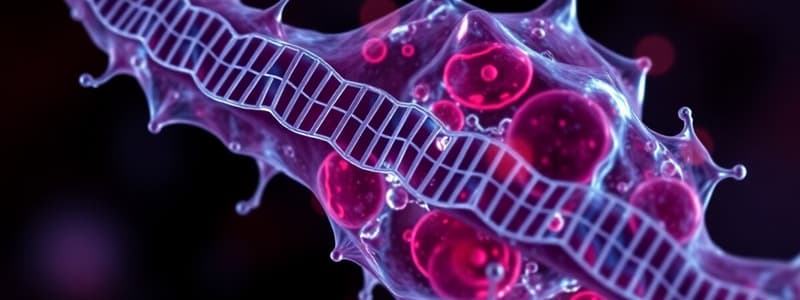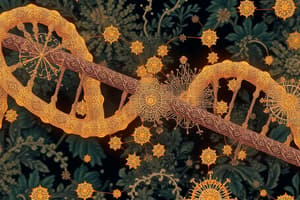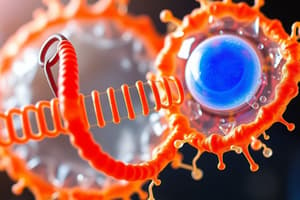Podcast
Questions and Answers
What is the primary function of DNA within a cell?
What is the primary function of DNA within a cell?
- To provide structural support to the cell.
- To form the cell membrane.
- To direct the functioning of the cell. (correct)
- To transport nutrients.
What term describes the area outside of the cell?
What term describes the area outside of the cell?
- Organelle
- Intracellular
- Extracellular (correct)
- Cytosolic
What technique is used to isolate organelles within a cell?
What technique is used to isolate organelles within a cell?
- Cell homogenization (correct)
- Cell activation
- Cell dilution
- Cell fragmentation
What is the purpose of differential centrifugation?
What is the purpose of differential centrifugation?
Which component of the cell membrane faces the aqueous environment?
Which component of the cell membrane faces the aqueous environment?
What is the fluid mosaic model referring to?
What is the fluid mosaic model referring to?
What is the cytoplasm primarily composed of?
What is the cytoplasm primarily composed of?
What is the function of organelles within the cytoplasm?
What is the function of organelles within the cytoplasm?
Which part of the cell membrane is hydrophobic?
Which part of the cell membrane is hydrophobic?
What is the primary function of the cell membrane?
What is the primary function of the cell membrane?
Which of the following is NOT a component of the nucleus?
Which of the following is NOT a component of the nucleus?
Which of these organelles is classified as membranous?
Which of these organelles is classified as membranous?
What role does the nucleolus play within the nucleus?
What role does the nucleolus play within the nucleus?
What is a major role of the endoplasmic reticulum?
What is a major role of the endoplasmic reticulum?
Which of the following organelles is involved in the export of molecules?
Which of the following organelles is involved in the export of molecules?
Which structure allows for exchange between the nucleoplasm and the cytoplasm?
Which structure allows for exchange between the nucleoplasm and the cytoplasm?
What is the semi-permeable nature of the cell membrane responsible for?
What is the semi-permeable nature of the cell membrane responsible for?
What composes chromatin in the nucleus?
What composes chromatin in the nucleus?
Which organelle is known as the 'powerhouse' of the cell?
Which organelle is known as the 'powerhouse' of the cell?
What is the primary function of lysosomes in the cell?
What is the primary function of lysosomes in the cell?
Which condition is characterized by the buildup of lipids in brain cells?
Which condition is characterized by the buildup of lipids in brain cells?
What are the two types of ribosomes found in eukaryotic cells?
What are the two types of ribosomes found in eukaryotic cells?
Apoptosis is crucial for which of the following processes in multicellular organisms?
Apoptosis is crucial for which of the following processes in multicellular organisms?
What is a consequence of lysosomal enzyme deficiencies?
What is a consequence of lysosomal enzyme deficiencies?
Which ribosome subunit configuration exists in prokaryotic cells?
Which ribosome subunit configuration exists in prokaryotic cells?
Which of the following disorders is NOT associated with ribosome malfunction?
Which of the following disorders is NOT associated with ribosome malfunction?
What process is exemplified by the removal of improperly growing cells during development?
What process is exemplified by the removal of improperly growing cells during development?
What is often the outcome of lysosomal storage diseases?
What is often the outcome of lysosomal storage diseases?
What are polyribosomes?
What are polyribosomes?
What is the primary function of mitochondria in cells?
What is the primary function of mitochondria in cells?
Which component of the mitochondrion is responsible for housing enzymes of the citric acid cycle?
Which component of the mitochondrion is responsible for housing enzymes of the citric acid cycle?
Which statement accurately describes mitochondrial DNA?
Which statement accurately describes mitochondrial DNA?
What distinguishes the inner mitochondrial membrane from the outer membrane?
What distinguishes the inner mitochondrial membrane from the outer membrane?
What role do mitochondria play in aging?
What role do mitochondria play in aging?
What is a common characteristic of mitochondrial deficiency diseases?
What is a common characteristic of mitochondrial deficiency diseases?
What type of molecules can pass into the nucleus without regulation?
What type of molecules can pass into the nucleus without regulation?
What is a possible consequence of nuclear breakdown?
What is a possible consequence of nuclear breakdown?
Which disorder has been linked to defective nucleoli?
Which disorder has been linked to defective nucleoli?
What role does the smooth endoplasmic reticulum primarily serve?
What role does the smooth endoplasmic reticulum primarily serve?
Which component is NOT found in the cytoplasm?
Which component is NOT found in the cytoplasm?
How are rough and smooth endoplasmic reticulum similar?
How are rough and smooth endoplasmic reticulum similar?
What type of antibodies are associated with autoimmune diseases related to chromatin organization?
What type of antibodies are associated with autoimmune diseases related to chromatin organization?
What is a primary function of the rough endoplasmic reticulum?
What is a primary function of the rough endoplasmic reticulum?
Which of the following is NOT a characteristic of the cytoplasm?
Which of the following is NOT a characteristic of the cytoplasm?
Which of the following best describes the function of the smooth endoplasmic reticulum regarding calcium ions?
Which of the following best describes the function of the smooth endoplasmic reticulum regarding calcium ions?
Flashcards are hidden until you start studying
Study Notes
Cell Structure and Function
- DNA (deoxyribonucleic acid) directs cell functioning, located in the nucleus.
- Cytoplasm is the area between the cell membrane and nucleus, containing cytosol and organelles.
- Intracellular refers to the inside of the cell, while extracellular refers to the outside area.
Importance of Studying Cells
- Cells form tissues, which form organs, leading to the structure of bodies.
- Cells are responsible for all life processes.
Methods of Studying Cells
- Biochemical techniques are used to study cells, including:
- Cell fractionation, which isolates organelles via homogenization and ultracentrifugation.
Cell Membrane
- Also known as the plasma membrane, it consists of a phospholipid bilayer.
- Structure includes:
- Hydrophilic phosphate heads facing away from fatty tails.
- Hydrophobic fatty acid tails facing inward, preventing water-soluble substances from passing freely.
- Properties include:
- Semi-permeability to control substance transport.
- Functions in cell communication and attachment to other cells and structures.
Organelles in Eukaryotic Cells
- Key organelles include:
- Nucleus
- Endoplasmic reticulum (ER)
- Golgi apparatus
- Lysosomes
- Mitochondria
- Peroxisomes
- Ribosomes
- Organelles can be membranous (e.g., ER, mitochondria) or non-membranous (e.g., ribosomes).
Nucleus
- Largest organelle in animal cells, protects genetic material.
- Composed of:
- Nuclear membrane, which contains pores for material exchange.
- Nucleoplasm, the fluid within.
- Nucleolus, for ribosome synthesis.
- Chromatin, which condenses into chromosomes during cell division.
Disorders of the Nucleus
- Defective nucleoli are linked to hereditary diseases like Alzheimer’s and Huntington's.
- Antinuclear antibodies are associated with autoimmune diseases.
Cytoplasm
- Gel-like substance where most biochemical reactions occur.
- Contains water, salts, enzymes, and organelles necessary for cell function.
Endoplasmic Reticulum (ER)
- Network of membranes divided into:
- Rough ER, studded with ribosomes for protein synthesis.
- Smooth ER, involved in lipid synthesis, detoxification, and calcium storage.
Lysosomes
- Digestive organelles that process waste and cellular leftovers.
- Tay-Sachs disease is a major lysosomal storage disease where lipids accumulate in brain cells.
Ribosomes
- Sites of protein synthesis, composed of rRNA and proteins.
- Can be free in the cytoplasm or bound to the ER.
- Defects can lead to conditions such as anemia and Shwachman-Diamond syndrome.
Mitochondria
- Known as the powerhouses of the cell, responsible for energy production through cell respiration.
- Composed of:
- Outer and inner membranes, with the inner folded into cristae, encasing the matrix.
- Contains its own DNA and ribosomes, allowing self-replication.
Mitochondrial Disorders
- Higher mutation rates lead to muscular dysfunction and other diseases.
Apoptosis
- Programmed cell death, critical for development and removal of damaged cells.
- Dysfunction in this process can contribute to cancer development.
Key Takeaways
- Cell structure and function are interdependent, with essential roles played by organelles.
- Understanding cell biology is crucial for exploring various diseases and their treatments.
Studying That Suits You
Use AI to generate personalized quizzes and flashcards to suit your learning preferences.




